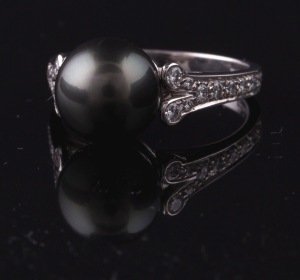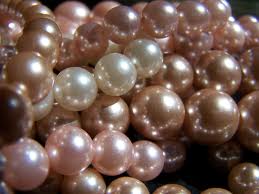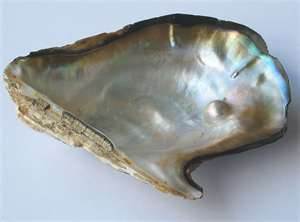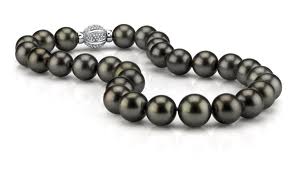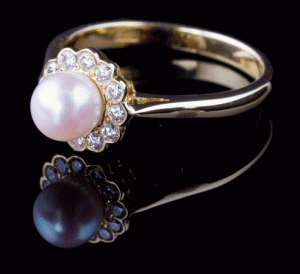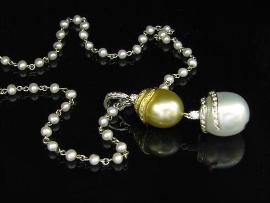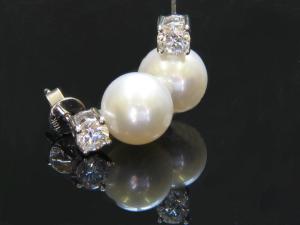THE HISTORY OF PEARL HUNTING AND PEARL FARMING
PEARL HUNTING
- For thousands of years, most seawater pearls were retrieved by divers working in the Indian Ocean, in areas like the Persian Gulf, the Red Sea, and the Gulf of Mannar. Starting in the Han Dynasty (206 BC – 220 AD), the Chinese hunted extensively for seawater pearls in the South China Sea. In the 14th century Arabian Sea, the traveller Ibn Battuta provided the earliest known description of pearl diving by means of attaching a cord to the divers waist.
CATCHING PEARLS – BERN PHYSIOLOGUS (IX CENTURY)
- When Spanish conquistadors arrived in the Western Hemisphere, they discovered that around the islands of Cubagua and Margarita, some 200km north of the Venezuelan coast, was an extensive pearl bed (a bed of pearl oysters). One discovered and named pearl, La Peregrina pearl, was offered to the Spanish Queen. According to Garcilasso de la Vega who says that he saw La Peregrina at Seville in 1507, (Garicilasso, “Historie des Incas, Rois du Perou,” Amsterdam, 1704, Vol, II, P.352) this was found at Panama in 1560 by a negro who was rewarded with his liberty, and his owner with the office of accolade of Panama.
- Margarita pearls are extremely difficult to find today and are known for their unique yellowish colour. The most famous Margarita necklace that anyone can see today is the one that the Venezuelan President Romulo Betancourt gave to Jacqueline Kennedy when she and her husband, Predient John F Kennedy paid an official visit to Venezuela.
- Before the beginning of the 20th century, pearl hunting was the most common way of harvesting pearls. Divers manually pulled oysters from the ocean floors and river bottoms and checked them individually for pearls. Not all mussels and oysters produce pearls. In a haul of three tones, only three or four oysters will produce perfect pearls.
THE DEVELOPMENT OF PEARL FARMING
- Today, the cultured pearls on the market can be divided into two categories. The first category covers the beaded cultured pearls, including Akoya, SouthSea and Tahiti. These pearls are gonad grown, and there is usually one pearl grown at a time. This limits the number of pearls at a harvest period. The pearls are usually harvested after one year for Akoya, 2-4 years for SouthSea and Tahitian, and 2-7 years for freshwater. This perliculture process was first developed by the British biologist Willian Saville-Kent who passed the information along to Tatsuhei Mise and Tokichi Nishikawa from Japan. The second category includes the non-beaded freshwater cultured pearls and the Biwa or Chinese pearls. As they grow in the mantle, where on each wing up to 25 grafts can be implanted, these pearls are much more frequent and do saturate the market completely. An impressive improvement of quality has taken place in the last ten years when the former rice grain shaped pebbles are compared with the near round pearls of today.
- The nucleus bead in a beaded cultured pearl is generally a polished sphere made from freshwater mollusc shell. Along with a small piece of mantle tissue from another mollusc (donor shell) to serve as a catalyst for the pearl sac, it is surgically implanted into the gonad (reproductive organ) of a saltwater mollusc. In freshwater periculture, only the piece of tissue is used in most cases, and is inserted into the fleshy mantle of the host mussel. SouthSea and Tahitian pearl oysters, also known as Pinctada maxima and pintada margaritifera, which survive the subsequent surgery to remove the finished pearl, are often implanted with a new, larger bead as part of the same procedure and then returned to the water for another 2-3 years of growth.
WHITE PEARL NECKLACE
- Despite the common misperception, Mikimoto did not discover the process of pearl culture. The accepted process of pearl culture was developed by the British Biologist William Saville-Kent in Australia and brought to Japan by Tokichi Nishikawa and Tatsuhei Mise. Nishikawa was granted the petent in 1916, and married the daughter of Mikimoto. Mikimoto was able use Nishikawa’s technology. After the patent was granted in 1916, the technology was immediately commercially applied to Akoya pearl oysters in Japan in 1916. Mise’s brother was the first to produce a commercial crop of pearls in the Akoya oyster. Mitsubishi’s Baron Iwasaki immediately applied the technology to the SouthSea pearl oyster in 1917 in the Phillipines, and later in Buton, and Palau. Mitsubishi was the first to produce a cultured SouthSea pearl – although it was not until 1928 that the first small commercial crop of pearls was successfully produced.
- The original Japanese cultured pearls, known as Akoya pearls, are produced by a species of small pearl oyster, Pinctada fucata martensii, which is no bigger than 6-8 cm in size, hence Akoya pearls larger than 10 mm in diameter are extremely rare and highly prized. Today, a hybrid mollusc is used in both Japan and China in the production of Akoya pearls. It is a cross between the original Japanese species, and the Chinese species Pinctada chemnitzii.
RECENT PEARL PRODUCTION
- China has recently overtaken Japan in Akoya pearl production. Japan has but ceased its production of Akoya pearls smaller than 8mm. Japan maintains its status as a pearl processing centre, however, and imports the majority of Chinese Akoya pearl production. These pearls are then processed (often simply matched and sorted), relabelled as product of Japan, and exported.
- In the past couple of decades, cultured pearls have been produced using larger oysters in the South Pacific and Indian Ocean. The largest pearl oyster is the Pinctada maxima, which is roughly the size of a dinner plate. SouthSea pearls are characterised by there large size and warm lustre. Sizes up to 14mm in diameter are not uncommon. SouthSea pearls are primarily produced in Australia, Indonesia and the Phillipines.
- Mitsubishi commenced pearl culture with the SouthSea pearl oyster in 1916, as soon as the technology patent was commercialised. By 1931 this project was showing signs of success, but was ipset ny the death of Tatsuhei Mise. Although the project was recommenced after Tatsuhei’s death, the project was discontinued at theh beginning of WWII before significant production of pearls was achieved.
- After WWII, new SouthSea pearl projects were commenced in the early 1950’s in Burma and KuriBay and Port Essington in Australai. Japanese companies were involved in all projects using technicians from the original MitsubishiSouthSea pre-war projects.
FRESHWATER PEARL FARMING
- In 1914, pearl farmers began growing cultured freshwater pearls using the pearl mussels native to LakeBiwa. This lake, the largest and most ancient in Japan, lies near the city of Kyoto. The extensive and successful use of the Biwa pearl mussel is reflected in the name Biwa Pearls, a phrase which was at the time nearly synonymous with freshwater pearls in general. Since the time of peak production in 1971, when Biwa pearl farms produced six tons of cultured pearls, poloution has caised the virtual extinction of the industry. Japanese pearl farmers recently cultured ahybrid pearl mussel – a cross between a Biwa pearl mussel and a closely related species from China, Hyriopsis cumingi, in LakeKasumigaura. This industry has also nearly ceased production due ton pollution.
- Japanese pearl producers also invested in producing cultured pearls with freshwater mussels in the region of Shanghai, China. China has since become the worlds largest producer of freshwater pearls, producing more than 1,500 metric tons a year (in addition to metric measurements, Japanese units of measurements such as the kan and momme are sometimes encountered in the pearl industry).
- Led by pearl pioneer John Latendresse and his wife Chessy, the United States began farming cultured freshwater pearls in the mid 1960’s. National Geographic Magazine introduced the American cultured pearl as a commercial product in their August 1985 issue. The Tennessee pearl farm has emerged as a tourist destination in recent years, but commercial production of freshwater pearls has ceased.
PEARL IN JEWELLERY
- The value of the pearls in jewellery is determined by a combination of lustre, colour, size, lack of surface flaws and a symmetry that are appropriate for the type of pearl under consideration. Among those attributes, lustre is the most important differentiator of pearl quality according to jewellers.
- All factors being equal, however, the larger the pearl the more valuable it is. Large, perfectly round pearls are rare and highly valued. Teardrop-shaped pearls are often used in pendants.
SHAPES
- Pearls come in eight basic shapes: round, semi-round, button, drop, pear, oval, baroque and circled. Perfectly round pearls are the rarest and most valuable shape. Semi-rounds are also used in necklaces or in pieces where the shape of the pearl can be disguised to look like it is a perfectly round pearl. Button pearls are like flattened round pearls and can also make a necklace, but more often are used in single pendants or earrings where the back half of the pearl is covered, making it look like a larger, rounder pearl.
- Drop and pear shaped pearls are sometimes referred to as teardrop pearls and are most often seen in earrings, pendants, or as a centre pearl in a necklace. Baroque pearls have a different appeal; they are often highly irregular with unique and interesting shapes. They are also commonly seen in necklaces. Circled pearls are characterised by there concentric ridges, or rings, around the body of the pearl.
- In general, cultured pearls are less valuable than natural pearls, whereas imitation pearls almost have no value. One way that jewellers can determine whether a pearl is a cultured or natural is to have a gem lab perform an x-ray of the pearl. If the x-ray reveals a nucleus, the pearl is likely a bead nucleated saltwater pearl. If no nucleus is present, but irregular and small dark inner spots indicating a cavity are visible, combined with concentric rings of organic substance, the pearl is likely a cultured freshwater. Cultured freshwater pearls can often be confused for natural pearls which present homogenous pictures which continuously darken toward the surface of the pearl. Natural pearls will often show larger cavities where organic matter has dried out and decomposed.
- Some imitation pearls are simply made of mother-of-pearl, coral or conch shell, while others are made from glass and are coated with a solution containing fish scales called essence d’Orient. Although imitation pearls look the part, they do not have the same weight or smoothness as real pearls, and their lustre will also dim greatly.
COLOURS OF PEARL JEWELLERY
- Earrings and necklaces can also be classified on the grades of the colour of the pearl. While white, and more recently black, saltwater pearls are by far the most popular, other colour tints can be found on pearls from the oceans. Pink, blue, champagne, green, black and even purple saltwater pearls can be encountered, but to collect enough of these rare colours to form a complete string of the same size and same shade can take years.

